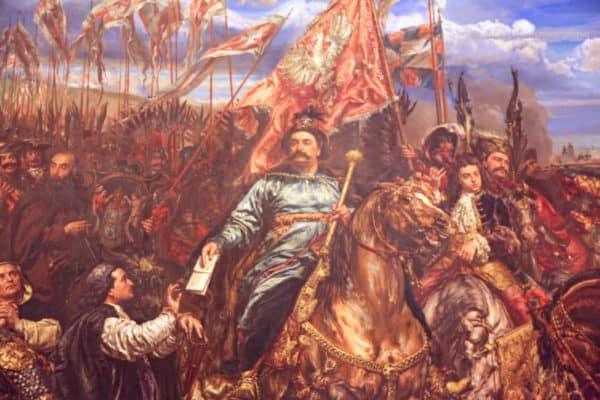King Sobieski Monument Erected in Kraków After Vienna Says It’s Too Controversial
- Post AuthorBy Henry Wolff
- Post DateTue Nov 26 2019
Jan III Sobieski sending Message of Victory at Vienna to the Pope.
A monument of Polish king Jan III Sobieski has been placed on a platform trailer in front of the Papal Window in Kraków.
The monument has been put on temporary display to remind people of its existence after authorities in Vienna withdrew from a long-term plan to erect it on Kahlenberg hill in Vienna, from where the Polish king launched his history-changing attack 336 years ago.
The monument depicts Sobieski as the head of a column of hussars as he routed the Ottoman army at the Siege of Vienna in 1683, a battle that put a check on the Ottomans’ further advances into Europe.
Up to now, thirteen attempts have been made to erect a monument in Vienna in honour of the Polish king who relieved the siege of the city. This latest attempt looked set to be successful.
The foundation stone for the monument in Vienna was laid six years ago on the 330th anniversary of the battle. The unveiling of the monument was planned for 12 September 2018 on the 335th anniversary of the relief of Vienna.
However, last July, the new mayor of Vienna, Michael Ludwig, announced that he was withdrawing from the project.
Piotr Zapart, initiator of the project and chairman of the monument’s organising committee said in an interview with radio station RMF FM, “We had all the agreements in place; the cooperation with Vienna, as well as with Kraków was great; there was a signed agreement between the Mayor of the Kraków, Jacek Majchrowski, and the Mayor of Vienna, Michael Häupel.
“On 11 July, President Jacek Majchrowski and I were invited to meet the new mayor Michael Ludwig. And there we were told that a new committee had said that the monument did not meet the artistic standards, was archaic and therefore Vienna withdrew its consent.”
In its letter to the organising committee, the authorities in Vienna, fearing that the monument may be perceived as anti-Turkish, stated that it was not an appropriate time to erect military monuments.
The monument’s creator Czesław Dźwigaj said that the eight-metre long work weighing three tonnes featuring Sobieski on a horse does not feature any Turkish or Islamic symbols.
He also pointed out that in Vienna there are two monuments of Crimean Tartars who took part in the relief of Vienna and fought alongside Sobieski.
In the place where the monument was to be erected, everything is ready. The pedestal is already there and the area around it has been cobblestoned. On both sides of the pedestal there was to be an inscription in Polish and German ‘King of Poland Jan III Sobieski’ with the date of the battle.
The monument’s placement on a platform trailer normally used to haul broken-down cars symbolises that it is still on the road to its final destination in the Austrian capital.
It will stand in Kraków for a maximum of two weeks according to local authorities in the city. Later, it will move on to Nowy Sącz, Brzeg and Nysa, places that are connected with the life of the king, and possibly to Warsaw, where it would stand in front of the Royal Castle.
Zapart is determined that the monument will stand in Vienna: “Neither before nor now have we considered any other final location of the monument than Vienna. We believe that the worthiest place for the king is the Vienna Kahlenberg,” he said.
- Post TagsEastern Europe, Europe, Poland, Signs of Hope
